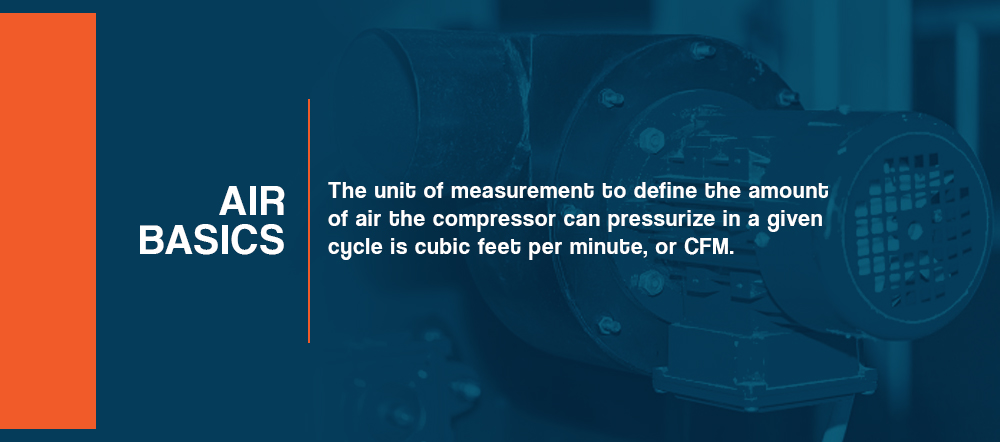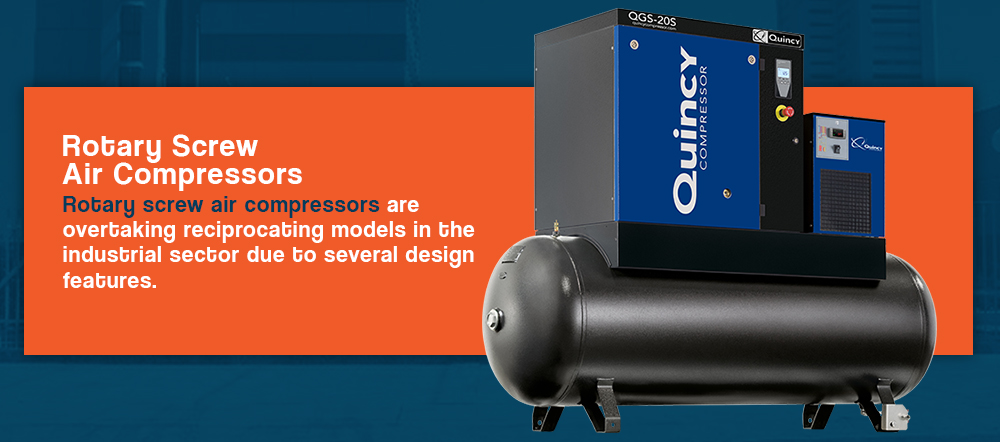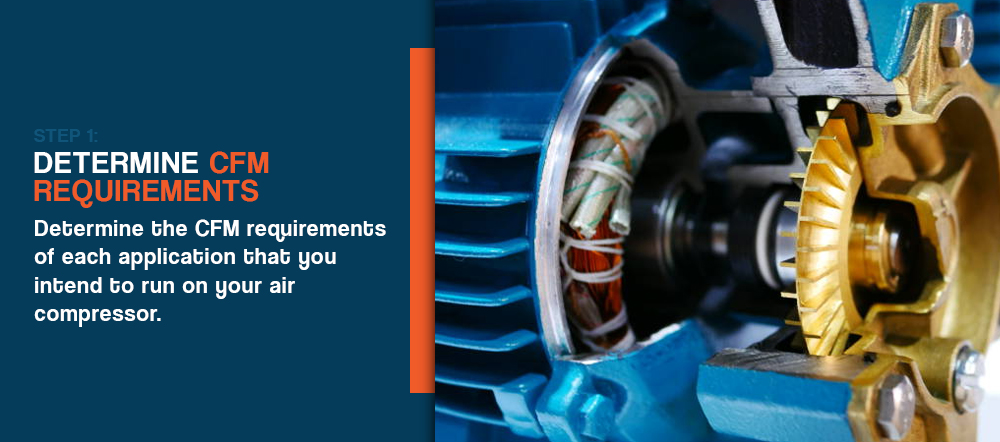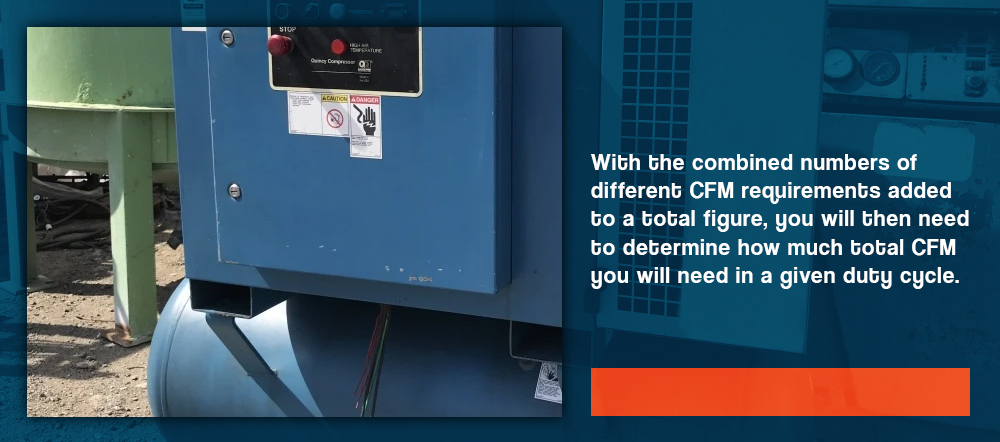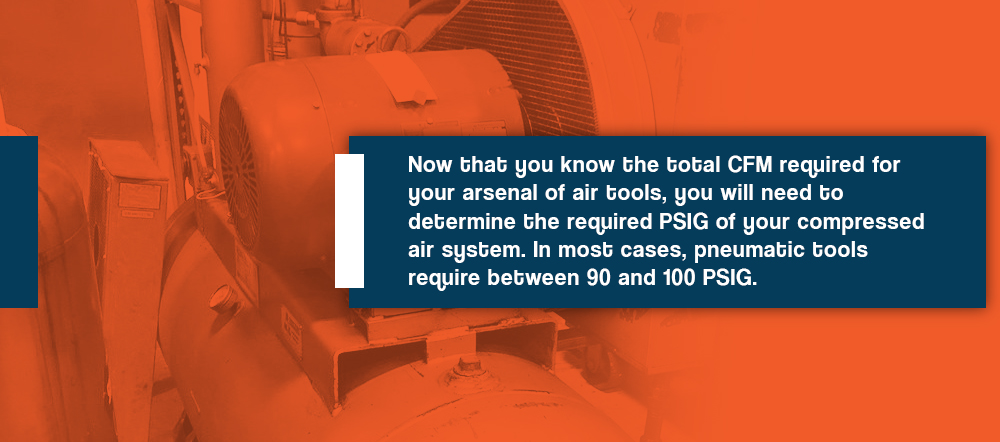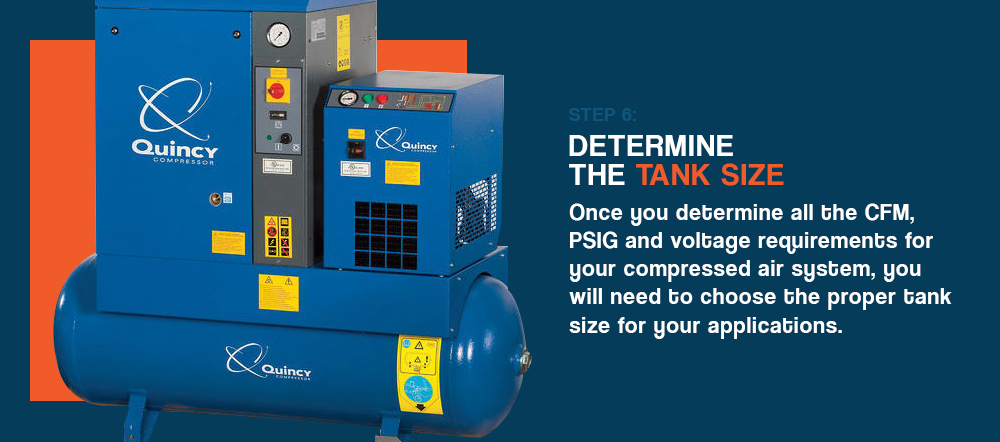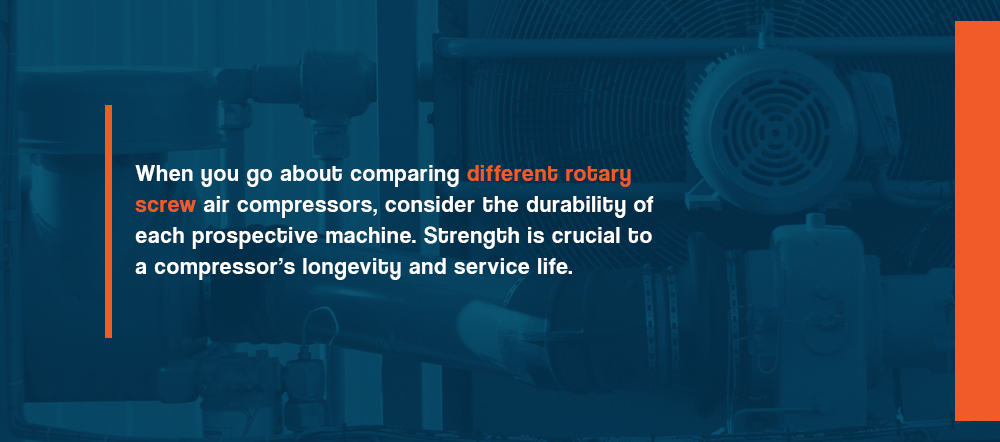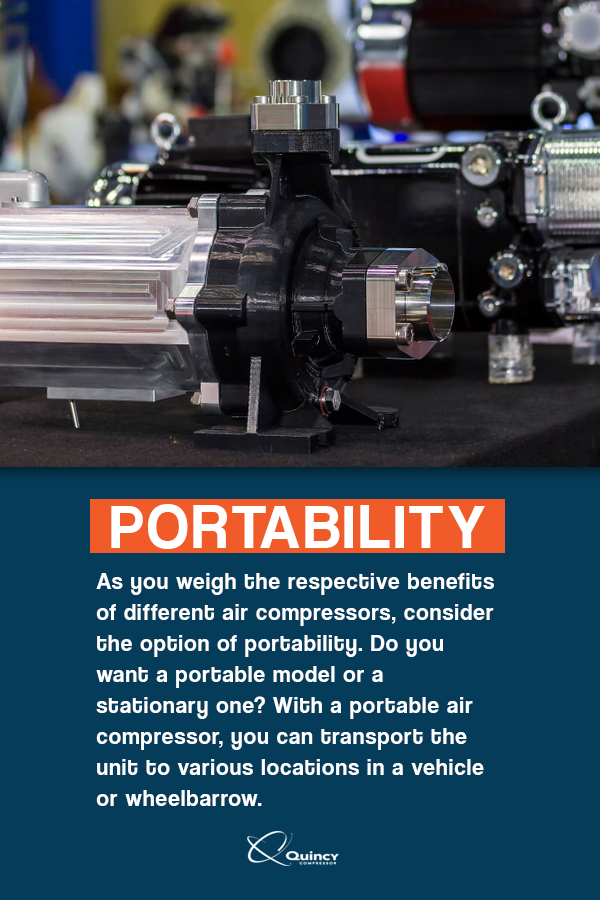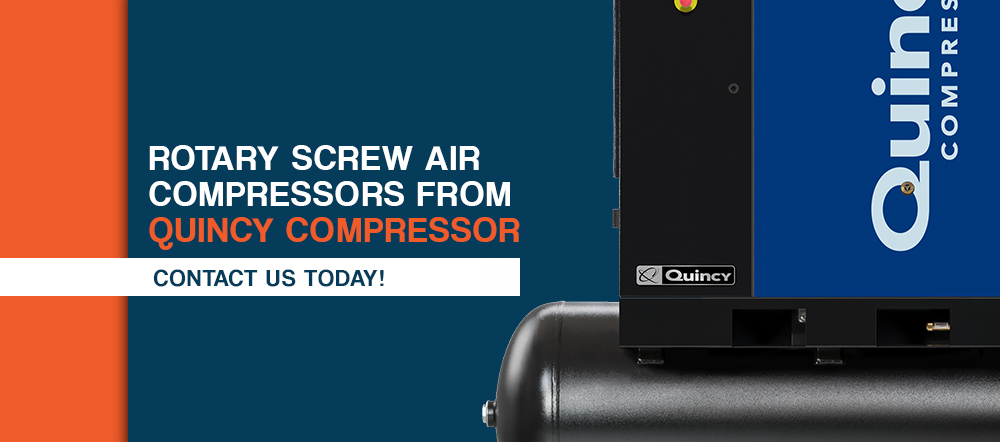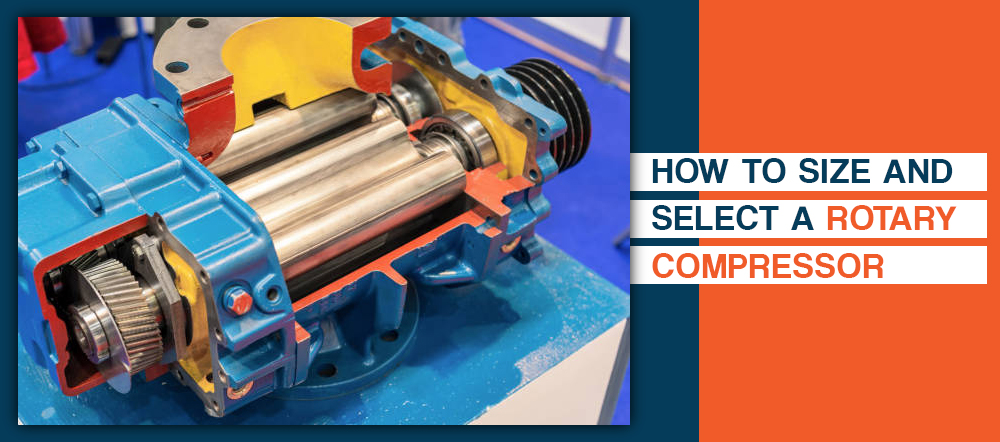
Compressed air serves numerous industrial and personal functions. As the fourth utility in industry, compressed air is largely responsible for the assembly of appliances and automobiles. Most of the furniture and vehicles you see each day are the result of air-powered arms and pneumatic fasteners along conveyor belts. Pressurized air is also largely responsible for the buildings where you work, shop, dine and live.
Selecting the right air compressor can be a challenging task if you are new to the technology, because the process is more complicated than picking out a unit. The following article answers the question, “How do I know what size rotary screw compressor I need?” by outlining how to choose a rotary screw compressor that meets your needs.
Air Basics
An air compressor turns regular air into a form of power through a process of pressurization. The process works as follows:
- Ambient air gets sucked into the compressor and sent through one or two pressurization cylinders.
- Moisture gets extracted and drained as the air gets compressed to the desired pounds per square inch (PSI).
- Once the air leaves the machine and travels to its endpoint, the cycle concludes.
The unit of measurement to define the amount of air the compressor can pressurize in a given cycle is cubic feet per minute, or CFM. This metric is critical in determining how to size a rotary compressor, and whether a given air compressor has the capacity for your tools and applications. There are three ways to define CFM.
- Displaced CFM: This number derives from calculations of the stroke, bore and rotations per minute in a given process. The problem with DCFM as a measurement standard is that it loses sight of other factors, such as external pressure, atmospheric heat, moisture, humidity, vibration or friction. Consequently, DCFM is not a reliable metric for determining the capacity of an air compressor.
- Standard CFM: The calculations at play here are generally more relevant than those of DCFM. Standard CFM comes from the regular conditions of atmospheric air, as defined by the air pressure at sea level. In normal circumstances, this would be 14.5 PSI and 68 degrees Fahrenheit with no humidity. The SCFM metric is the most accurate one to use when you make comparisons between different types of air compressors. Still, your needs could vary based on the location of your operations. After all, the atmospheric conditions in middle America are different than those experienced in coastal states.
- Actual CFM: This metric is the most crucial when it comes to air compressors because it derives from the factors of a given working environment. In a factory, the ACFM comes from the cubic feet per minute of pressurized air amid the heat, humidity and other external factors. However, ACFM can be hard to gauge when you purchase an air compressor, because you can only determine this metric once the machine is up and operating within a work facility. Therefore, an on-site engineer must calculate the ACFM of an air compressor after setting up the equipment.
Overall, SCFM is the best metric to use when selecting an air compressor. Some models provide a CFM range to indicate the performance of a select machine at various levels of pressure. While this can make it difficult to compare the CFM of different air compressors, SCFM remains the most accurate metric for making capacity determinations on this front.
If you are selecting the appropriate air compressor based on CFM, be sure to add an extra 30% allowance for any possible surges. In specific instances, an air tool can act unpredictably if pressure occurs in the pipe or atmospheric conditions impact the performance of the air compressor. Sometimes, it takes more air pressure than would usually be required to perform a standard function. Therefore, if your arsenal of pneumatic tools brings your system to a collective CFM requirement of 90, you would need a machine with at least 120 CFM to accommodate for those unplanned moments.
Reciprocating compressors are the most common type of compressor found in workshops. The reciprocating compressor consists of a crankshaft drive that traps and pressurizes incoming air by a piston that moves back and forth. When the piston retracts, ambient air gets sucked into the compressor through the inlet valve. When the piston extends, it strips the trapped air of its volume and turns it into a form of power.
Reciprocating compressors consist of various moving parts. Due to the back-and-forth movement of the piston and the friction this causes, reciprocating compressors are typically loud machines with hot internal components. Newer models have features to reduce heat and noise. Reciprocating compressors come in two basic types: single- and dual-stage. A single-stage compressor consists of one cylinder. The dual-stage also has a second, smaller cylinder to further compress pressurized air.
Rotary Screw Air Compressors
Rotary screw air compressors are overtaking reciprocating models in the industrial sector due to several design features. In a reciprocating air compressor, air gets sucked through an inlet valve into a cylinder, then squeezed through a pair of counter-turning helical screws. You can then use the newly pressurized air for various pneumatic tools and applications, such as nailing, screwing, cutting, sanding, drying, painting and searing.
If you’re wondering how to select a rotary screw compressor for your operations, you should consider that they contain fewer moving parts, and therefore make little noise and generate less heat during duty cycles. Thanks to the relative simplicity of their design, rotary screw air compressors require less maintenance and generally offer superior service life. Rotary compressors are available in portable and stationary varieties suited for a range of personal and industrial uses.
Air Compressor Selection Guide
How do you choose a compressor? Below, we have outlined how to choose the right air compressor for you.
Step 1: Determine CFM Requirements
Determine the CFM requirements of each application that you intend to run on your air compressor. Most applications require between two and 13 CFM. For example, a pneumatic wrench will operate on as little as two and a half CFM. Depending on the size of the tool and the amount of air pressure needed for the application at hand, an air wrench could require as much as five CFM. Meanwhile, pneumatic shears will need between eight and 16 CFM to operate.
As a general rule, tools that perform simple fastening tasks like nailing and screwing will only need up to five CFM, whereas tools made for cutting and sanding require two or three times as much.
Step 2: Calculate the Total Air Requirements
Once you determine each of the CFM requirements for the tools and applications that you intend to run from your air compressor, add those numbers up for the total. For example, if you plan to run an airbrush that requires up to 15 CFM, a pneumatic sander that requires up to 16 CFM, a pneumatic nailer that needs up to five CFM, a pneumatic wrench needs up to five CFM and a pneumatic saw that needs up to 16 CFM, your total combined requirements would be 57.
When you add an extra 20 CFM allowance for possible surges, you would be at 77 CFM during times when all processes run at the same time.
Step 3: Calculate the Needed CFM
With the combined numbers of different CFM requirements added to a total figure, you will then need to determine how much total CFM you will need in a given duty cycle. For example, if you expect the tools to be active for 70% of each duty cycle, you would need to multiply your total combined air requirements by 0.7.
Going by the figure in step 2, the calculation for how much CFM you need in an air compressor would work as follows: 77 x 0.7 = 53.9 CFM. Thankfully, most rotary screw air compressors can offer well more than 53.9 CFM per duty cycle.
Step 4: Determine the Required PSIG
Now that you know the total CFM required for your arsenal of air tools, you will need to determine the required PSIG of your compressed air system. In most cases, pneumatic tools require between 90 and 100 PSIG. Tools specifically designed to supply air pressure, such as tire pumps, will usually need 150 PSIG.
While you can do this calculation on your own as you check the PSIG requirements of various tools, you should also go over these specs with your equipment manufacturer. Overall, you should purchase a machine that can handle everything simultaneously above and beyond the full requirements.
Step 5: Check Voltage and Phase
Depending on where you plan to situate your air compressor, you will need to know the voltage and phase available in that area. If you can’t access that information on your own, have an electrician examine your location to determine the voltage and phase. You will need this information to ensure you get your air compressor set up in an area with a sufficient energy source for the machine and its various peripheral attachments.
When you have everything powered on and are in the middle of various pneumatic applications, one of the worst things that could happen is for a fuse to blow and stop everything cold, halfway finished. Know the voltage and phase and select your air compressor accordingly.
Step 6: Determine the Tank Size
Once you determine all the CFM, PSIG and voltage requirements for your compressed air system, you will need to choose the proper tank size for your applications. Depending on whether you plan to operate at a small, medium or large scale, you will need to consider an air compressor size guide. The most common tank sizes in air compressors are 80 gallons, 120 gallons and 240 gallons.
If you plan to use your air compressor for projects in your home workroom or garage, an 80-gallon tank will probably meet your needs. If you intend to use your air compressor at a workshop with bigger tools on hand, you will need a larger tank of at least 120 gallons. If you are purchasing an air compressor for use in a factory with larger air-powered machines, you should buy an air compressor with a 240-gallon tank.
Consider the Durability of an Air Compressor
When you go about comparing different rotary screw air compressors, consider the durability of each prospective machine. Strength is crucial to a compressor’s longevity and service life. The investment you make upfront for a more robust machine can save you money in the long run because you will be less likely to encounter performance defects that could lead to costly maintenance bills. The features of an air compressor to check in this regard include the following.
- The cooling system: An air compressor should have an optimal cooling system to keep the motor from overheating on humid days, especially if you plan to put the machine in a warm environment. The fans inside the air compressor should be fast and long-lasting. If an air compressor has received poor reviews based on the strength or durability of its fans, consider alternative models.
- The frame and enclosure: Even if an air compressor consists of sturdy internal parts, the machine will not make a good purchase if its outer structure is weak. The strongest air compressors have heavy-duty steel frames as part of their construction. In an industrial setting, this protects the internal parts of an air compressor from damage if the machine gets struck by a cart or falling object. For added durability and aesthetic purposes, the enclosure should also have a powder coat or be finished with an electrostatic paint job, as this will help the finish resist wear and cracks.
- Cast-iron cylinder: One of the vital parts of an air compressor is the cylinder, as this is where each incoming supply of air gets pressurized for use at various endpoint applications. For optimal pressurization, the cylinder needs to be resilient through each duty cycle, year after year. With a cast-iron cylinder, an air compressor should have optimal durability in this pivotal area.
When you buy a compressor, select proper hoses for the fittings of the machine and corresponding tools. A slight variance in diameter could make a huge difference in terms of pressure and efficiency. A common mistake among newer users is to skimp by using quarter-inch hoses on machines and applications that demand three-eighths of an inch. Though the difference might seem slight, the discrepancy in air pressure is major when you consider the number of revolutions that occur during a duty cycle.
Aside from the quality of the air compressor itself, make sure that you purchase from a reputable seller with helpful service staff. Some key questions to ask about a prospective dealer include the following:
- How long has this company been in business? If the company has been around for many decades like Quincy Compressor, you can bet that they have a long history and millions of satisfied customers.
- Are compressors the primary or secondary product you sell? A company that specializes in air compressors will likely be more dedicated, knowledgeable and supportive than a warehouse that offers compressors as part of a larger, mostly unrelated inventory.
- Can you help answer questions about the features and details of each make and model in stock? Based on your intended use of a prospective model, you will likely have a list of specific questions that only an expert would be able to answer.
- What is the extent of your warranty and service help after you make the purchase? Ensure support will be readily available if and when issues arise, and that replacement parts are available if anything breaks down while the compressor is still under warranty. Verify that you can easily contact the seller via phone or email if necessary.
Before you choose an air compressor, consider the purchase price and how this investment will pan out in the long run. Based on your intended use of the machine, will you make good on the investment in terms of value or returns? If you plan to use the compressor for commercial purposes, how long will it take for you to earn back the purchase price? If you intend to use the compressor for household tasks, is the price of the compressor worth its value as a piece of machinery? Ideally, you should be able to recoup the cost of your purchase within a fraction of its performance life.
Noise Considerations
When you select an air compressor, consider the factor of noise and how this might affect your working environment. Would loud sounds be an issue, or do you want a quiet machine that makes the least amount of noise possible? If the machinery is too noisy, would you be willing to compromise in exchange for higher-quality air?
Concerns about noise could depend on whether you operate indoors or outdoors. If your compressor will be adjacent to other compartments where people work each day, a rotary screw air compressor would be the ideal choice because of the low noise. Even if a compressor does generate noise, solutions such as dampeners and enclosures can help you cut down on unwanted sounds.
Air Tools
Before you choose an air compressor, consider the types of tools you will use and the processes in question. If you are buying a compressor for projects such as furniture assembly and car work, you could do both with the movable option of a portable compressor. If you want a machine with the power to run industrial processes, you will need a larger air compressor.
Portability
As you weigh the respective benefits of different air compressors, consider the option of portability. Do you want a portable model or a stationary one? With a portable air compressor, you can transport the unit to various locations in a vehicle or wheelbarrow. If you drive a truck, you can mount the compressor in back and power it up whenever the need arises. If you have a flat tire, you would be able to rectify the situation immediately.
A portable air compressor also makes it possible to operate in a relatively small workspace on a semi-regular basis. Once you finish the job, you can put the unit in storage or move it to the next location.
Installation
If you opt instead for a stationary unit, you should have it installed by a professional who will be able to set up the compressor and fill you in on any local codes. The installer will also be able to test the compressor on the spot to make sure everything operates as designed.
Rotary Screw Air Compressors From Quincy Compressor
We hope this rotary air compressor selection guide makes picking a rotary compressor easier for you. For air compressors and tools, people have turned to Quincy Compressor for nearly a century. As America’s leading innovator in compressed air technology, we have led the way in making the air compressor into a vital component of industrial operations.
If you are looking to buy your first air compressor, Quincy will help you select a unit that could power the full range of operations at your facility. Check our product guide on rotary screw air compressors and contact us for more information.


